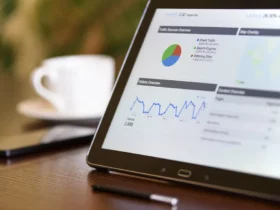Marketing analytics is the study of statistics for marketing objectives. By applying technology and analytical techniques to marketing-related data, businesses may improve their understanding of what drives consumer behavior, perfect their marketing strategy, and maximize their return on investment. This study helps marketers boost the return on marketing investment by identifying what is beneficial for driving conversions. Additionally, analytics makes sure that clients get more relevant ads instead of obnoxious messages—ones that are tailored to their own requirements and interests.
Let’s explore marketing analytics’ definition, operation, and significance in more detail.
Importance of marketing analytics
The need for correct data is more important than ever in the context of contemporary marketing. Consumers are becoming very picky about which branded media they interact with and which ones they choose to avoid.
Instead of using larger demographic associations to develop tailored personal advertisements based on individual interests, marketers must rely on precise data to capture the attention of the perfect buyer. This will enable marketing teams to offer the appropriate advertisement on the appropriate channel at the appropriate moment to advance customers through the sales funnel.
Data literacy
Data literacy is one of the key components of marketing analytics. Knowledge of data literacy is crucial for current corporate success. More data than ever is available to business users, but if they are unable to comprehend and analyze it, they won’t be able to make use of all of its value-creating potential. Data quality, teamwork, creativity, and work process efficiency may all increase for organizations that support data literacy. In practice, data literacy entails greater advantages with fewer drawbacks. Nowadays, businesses can turn to data literacy consultants for assistance if they are having problems achieving their goals for data literacy. Employees who are knowledgeable about data make better judgments and convey important information to others. Given that many firms are heading toward being more data-driven, data literacy is already a crucial skill.
Examples of marketing analytics
To maximize ROI, plan campaigns, and stay competitive, marketing analysis may be used in a variety of domains. Several instances of marketing analytics include:
- Segmenting customers
- Campaign schedule and planning
- Competitor research
- Workflow effectiveness
What sources are there for marketing data?
First-party data is the most valuable category of data since it provides insights into the attitudes, actions, and emotions of your audience. This type of data is collected directly by your business from users through various methods, such as crafting an online form to receive genuine information from your clients.
Client information exchanged with another entity is referred to as second-party data.
Third-party data is information that has been obtained and is being rented out or sold by organizations that are not associated with your business or users. Even though third-party data is gathered in large quantities and can provide information on users similar to yours, it isn’t the most reliable because it doesn’t come from your customers or a reliable second-party source.
Three components
Analysis of the present, reporting on the past, and future prediction are the three main facets of marketing data analytics
To gain a clear picture of where the marketing efforts stand and to compare them to previous campaigns, marketers must evaluate marketing data from current campaigns and activities. They will be concerned with website traffic and its sources, social media interaction and click-throughs, the status of the sales funnel, and revenue indicators in this situation.
At the conclusion of campaigns, marketing teams also rely on reported marketing data analytics, concentrating on metrics like lead conversion and sales funnel rate.
In the end, marketing organizations use marketing analytics to schedule upcoming tasks. Datasets, modeling, and AI are all used in this sort of marketing data analytics, which also includes lead scoring and upselling preparedness.

Improved customer experience
First-party data about your users’ encounters with your products may be collected and analyzed to learn how they feel about those interactions. Having this data can help your organization make improvements that address your customers’ needs and increase the likelihood that leads will turn into customers, whether their feelings are expressed explicitly (for example, in a survey) or implicitly in their behaviors (for example, leaving the website soon after loading the page).
How can businesses profit from marketing analytics?
Businesses will be able to respond to the analytics queries that are most important to their stakeholders by monitoring and reporting on company performance data and leading indicator metrics.
Regardless of the size of the organization, marketing analytics may offer priceless information that can spur expansion. Enterprise marketers may initially think the procedure is too complicated. However, the data gathered may assist a company of any size in expanding as long as marketing analytics are carefully vetted and appropriately deployed.
With the right marketing metrics and data, marketers may more effectively:
- Recognize broad marketing trends.
- Find out which initiatives were successful and why.
- Observe recurring patterns.
- Identify each program’s return on investment.
- Predict future outcomes.
Building credibility and saving time and money
By approaching marketing metrics and analytics with professionalism, marketers may earn the respect of their employers. This is accomplished by utilizing integrated technology to offer improved insights for better corporate decision-making. Achieving 5% greater returns on marketing spending and over 7% higher levels of growth parameters, marketers that engage in monitoring and controlling performance produce more value.
Moreover, proper marketing analytics increases effectiveness and saves time and money. The whole process is streamlined by offering a single platform for reporting across all media. Additionally, an integrated analytics strategy might free up 15% to 20% of marketing expenditures across sectors and countries.
Marketing analytics goes beyond being a great bonus. It’s one of the best ways to understand your customers’ journeys, tailor your outreach, and identify the parts of your campaigns that are working and the ones that aren’t. And having that knowledge is essential for your next internet marketing campaign. Analytics in marketing help companies see the larger picture. They can also go further into the more specialized, micro-marketing trends in their own businesses.
By enabling firms to target the most attractive customers and optimize their advertising, the data may increase both the quantity and quality of leads. Your bottom line is improved by all of this.









